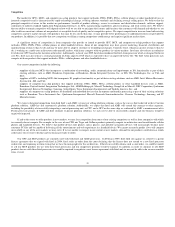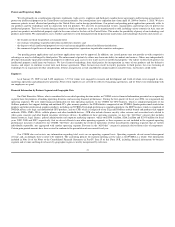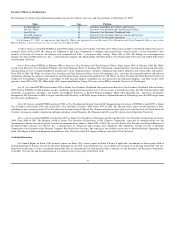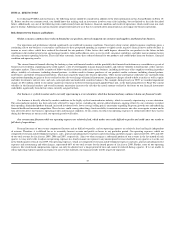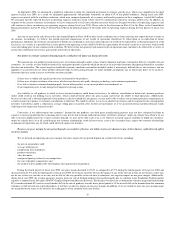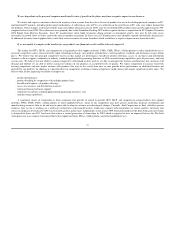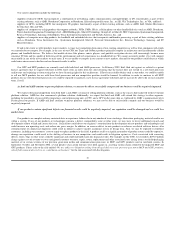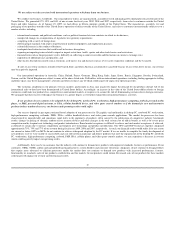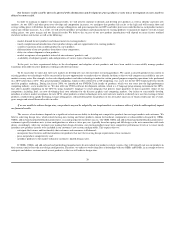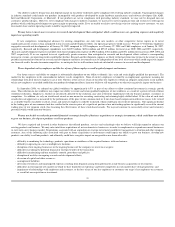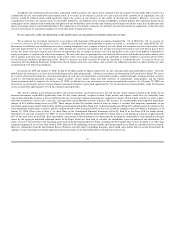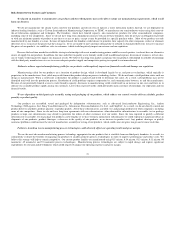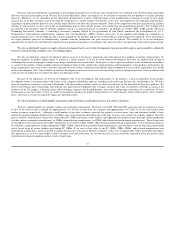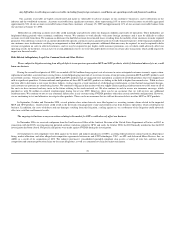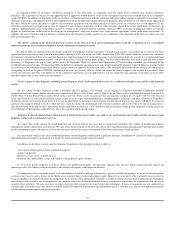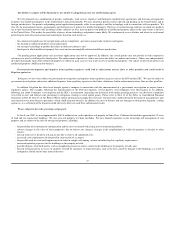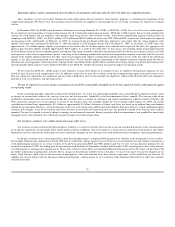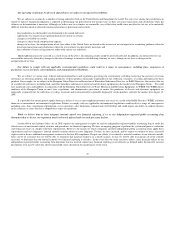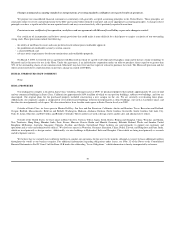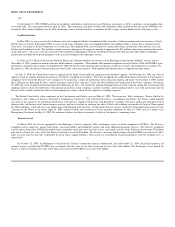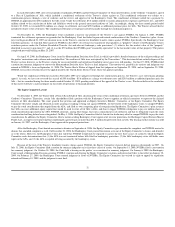NVIDIA 2008 Annual Report Download - page 25
Download and view the complete annual report
Please find page 25 of the 2008 NVIDIA annual report below. You can navigate through the pages in the report by either clicking on the pages listed below, or by using the keyword search tool below to find specific information within the annual report.
In addition, the consideration for any future acquisition could be paid in cash, shares of our common stock, the issuance of convertible debt securities or a
combination of cash, convertible debt and common stock. If we make an investment in cash or use cash to pay for all or a portion of an acquisition, our cash
reserves would be reduced which could negatively impact the growth of our business or our ability to develop new products. However, if we pay the
consideration with shares of common stock, or convertible debentures, the holdings of our existing stockholders would be diluted. The significant decline in the
trading price of our common stock would make the dilution to our stockholders more extreme and could negatively impact our ability to pay the consideration with
shares of common stock or convertible debentures. We cannot forecast the number, timing or size of future strategic investments or acquisitions, or the effect that
any such investments or acquisitions might have on our operations or financial results.
We are exposed to credit risk, fluctuations in the market values of our portfolio investments and in interest rates.
We account for our investment instruments in accordance with Statement of Financial Accounting Standards No. 115, or SFAS No. 115, Accounting for
Certain Investments in Debt and Equity Securities. All of the cash equivalents and marketable securities are treated as “available
-
for
-
sale” under SFAS No. 115.
Investments in both fixed rate and floating rate interest earning instruments carry a degree of interest rate risk. Fixed rate securities may have their market value
adversely impacted due to a rise in interest rates, while floating rate securities may produce less income than expected if interest rates fall. Due in part to these
factors, our future investment income may fall short of expectations due to changes in interest rates or if the decline in fair value of our publicly traded debt or
equity investments is judged to be other
-
than
-
temporary. We may suffer losses in principal if we are forced to sell securities that decline in securities market value
due to changes in interest rates. Future declines in the market values of our cash, cash equivalents and marketable securities could have a material adverse effect
on our financial condition and operating results. However, because any debt securities we hold are classified as “available
-
for
-
sale,” no gains or losses are
realized in our Consolidated Statements of Operations due to changes in interest rates unless such securities are sold prior to maturity or unless declines in value
are determined to be other
-
than
-
temporary.
At January 25, 2009 and January 27, 2008, we had $1.26 billion and $1.81 billion, respectively, in cash, cash equivalents and marketable securities. Given the
global nature of our business, we have invested both domestically and internationally. All of our investments are denominated in United States dollars. We invest
in a variety of financial instruments, consisting principally of cash and cash equivalents, asset
-
backed securities, commercial paper, mortgage
-
backed securities
issued by Government
-
sponsored enterprises, equity securities, money market funds and debt securities of corporations, municipalities and the United
States government and its agencies. As of January 25, 2009, we did not have any investments in auction
-
rate preferred securities. As of January 25, 2009, our
investments in government agencies and government sponsored enterprises represented approximately 71% of our total investment portfolio, while the financial
sector accounted for approximately 17% of our total investment portfolio.
The current volatility in the financial markets and overall economic uncertainty increases the risk that the actual amounts realized in the future on our
financial instruments could differ significantly from the fair values currently assigned to them. Other income and expense could also vary materially from
expectations depending on gains or losses realized on the sale or exchange of financial instruments; impairment charges related to debt securities as well as equity
and other investments; interest rates; and cash, cash equivalent and marketable securities balances. For instance, we recorded other than temporary impairment
charges of $9.9 million during fiscal year 2009. These charges include $5.6 million related to what we believe is an other than temporary impairment of our
investment in the money market funds held by the Reserve International Liquidity Fund, Ltd., or International Reserve Fund; $2.5 million related to a decline in the
value of publicly traded equity securities and $1.8 million related to debt securities held by us that were issued by companies that have filed for bankruptcy as of
January 25, 2009. Please refer to Note 17 of these Notes to the Consolidated Financial Statements in Part IV, Item 15 of this Form 10
-
K for further details.
Subsequent to year
-
end, on January 30, 2009, we received $84.4 million from the International Reserve Fund. This was our portion of a payout of approximately
65% of the total assets of the Fund. Each shareholder
’
s percentage of this distribution was determined by dividing the shareholder
’
s total unfunded redeemed
shares by the aggregate unfunded redeemed shares of the Fund, which was then used to calculate the shareholder
’
s pro rata portion of this distribution. We
expect to receive the proceeds of our remaining investment in the International Reserve Fund, excluding the $5.6 million that we have recorded as an other than
temporary impairment, by no later than October 2009, when all of the underlying securities held by the International Reserve Fund are scheduled to have matured.
However, redemptions from the International Reserve Fund are currently subject to pending litigation, which could cause further delay in receipt of our funds. In
addition, we may determine that further impairment of our investment in the International Reserve Fund may be necessary.
22


